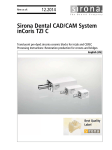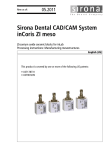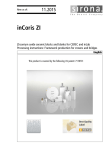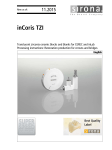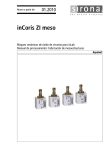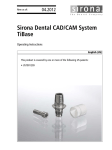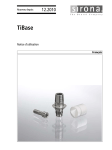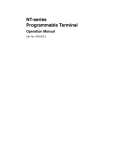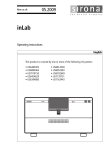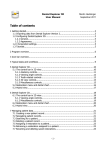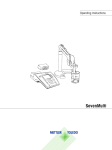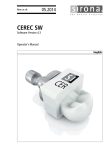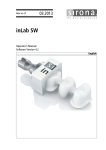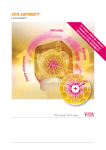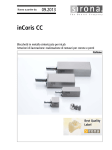Download inCoris ZI meso - Sirona - Technical Documentation
Transcript
kÉï=~ë=çÑW==
MNKOMNM
áå`çêáë=wf=ãÉëç
wáêÅçåáìã=çñáÇÉ=ÅÉê~ãáÅ=ÄäçÅâë=Ñçê=áåi~Ä
mêçÅÉëëáåÖ=áåëíêìÅíáçåëW=j~åìÑ~ÅíìêáåÖ=ãÉëçëíêìÅíìêÉë
båÖäáëÜ
Sirona Dental Systems GmbH
Table of contents
Zirconium oxide ceramic blocks for inLab
Table of contents
1
General.....................................................................................................................
3
2
Scope of supply........................................................................................................
4
3
Material.....................................................................................................................
5
4
Chemical composition ..............................................................................................
6
5
Technical data ..........................................................................................................
7
6
Area of application....................................................................................................
8
6.1
Indication .......................................................................................................
8
6.2
Contraindication ............................................................................................
8
Producing the mesostructure ...................................................................................
9
7.1
Scanning, designing and milling....................................................................
9
7.2
Design information ........................................................................................
9
7.3
Reworking the milled restoration ...................................................................
9
7.4
Sintering ........................................................................................................
9
7.5
Additional notes: procedure after sintering....................................................
10
7.6
Reworking the sintered mesostructure..........................................................
10
7.7
Veneer...........................................................................................................
11
8
Recommended tools and materials..........................................................................
12
9
Gluing the mesostructure to the titanium base.........................................................
13
10
References ...............................................................................................................
14
7
2
62 29 418 D3487
D3487.201.05.03.02 01.2010
Sirona Dental Systems GmbH
General
Zirconium oxide ceramic blocks for inLab
1
General
The product inCoris ZI meso bears the CE mark in accordance with the provisions of Council Directive 93/42/EEC of June 14, 1993 concerning medical
devices.
0123
inCoris ZI meso blocks are intended for use in manufacturing individually designed mesostructures, which are glued to a fitting titanium base after milling
and sintering.
Please also observe the instructions provided by the manufacturer of the titanium base or the implant.
Rx only
båÖäáëÜ
CAUTION: Federal law (USA) restricts sale of this device to or on the order of
a physician, dentist, or licensed practitioner.
62 29 418 D3487
D3487.201.05.03.02
01.2010
3
Scope of supply
Sirona Dental Systems GmbH
Zirconium oxide ceramic blocks for inLab
2
Scope of supply
inCoris Zi meso blocks are each available in two different colors and in two
different sizes for connecting to the titanium basis:
REF
Connection size
Color
62 31 802
S
F0.5
62 31 802
S
F0.5
62 31 828
S
F2
62 31 828
S
F2
62 31 810
L
F0.5
62 31 810
L
F0.5
62 31 836
L
F2
62 31 836
L
F2
The scanbodies are Sirona products and can be procured from dealers.
Lab implants and titanium bases can be procured from the implant manufacturer.
4
62 29 418 D3487
D3487.201.05.03.02 01.2010
Sirona Dental Systems GmbH
Material
Zirconium oxide ceramic blocks for inLab
3
Material
inCoris ZI meso ceramics constitute blocks comprised of zirconium oxide.
The blocks are initially delivered partially sintered; then, enlarged by the inLab
CAD/CAM system, they are individually processed to specification, and finally, densely sintered.
The advantages of inCoris ZI meso are:
High strength
●
Resistance to corrosion
●
Good biological compatibility of the product,
●
Coloration of the blocks to match adjacent teeth.
båÖäáëÜ
●
62 29 418 D3487
D3487.201.05.03.02
01.2010
5
Chemical composition
Sirona Dental Systems GmbH
Zirconium oxide ceramic blocks for inLab
4
6
Chemical composition
ZrO2+HfO2+Y2O3
> 99.0%
ZrO2+HfO2+Y2O3
> 99.0%
Al2O3
< 0.5%
Al2O3
< 0.5%
Other oxides
< 0.5%
Other oxides
< 0.5%
62 29 418 D3487
D3487.201.05.03.02 01.2010
Sirona Dental Systems GmbH
Technical data
Zirconium oxide ceramic blocks for inLab
5
Technical data
empty
Density:
6.06 g cm-3
Density:
6.06 g cm-3
Fracture toughness KIC
5.9 MPa m1/2
Fracture toughness KIC
5.9 MPa m1/2
Thermal expansion coefficient (20 - 500 °C):
11,0 10-6 K-1
Thermal expansion coefficient (20 - 500 °C):
11,0 10-6 K-1
Bending strength:
1200 MPa
Bending strength:
1200 MPa
båÖäáëÜ
The following specifications apply to material that is densely sintered in an inFire HTC sintering furnace:
Colors:
The blocks are tinted in the colors:
●
F0.5
●
F2
Therefore it is not necessary to carry out subsequent coloring using a submersion solution or liners.
62 29 418 D3487
D3487.201.05.03.02
01.2010
7
Area of application
Sirona Dental Systems GmbH
Indication
Zirconium oxide ceramic blocks for inLab
6
Area of application
6.1 Indication
inCoris ZI mesostructures can only be used for the intended titanium bases
or implants. Please refer to the instructions provided for the titanium base to
find out what connection size (S or L) is to be used for your inCoris ZI meso
block. Please observe the indications and contraindications of the implant.
6.2 Contraindication
8
●
Insufficient oral hygiene
●
Insufficient space available
●
Bruxism
●
For restorations with angulation correction of more than 20° to the implant
axis
●
For individual tooth restorations with free end saddle
●
For restorations with a length to implant length ratio of more than 1:1.25.
62 29 418 D3487
D3487.201.05.03.02 01.2010
Sirona Dental Systems GmbH
Producing the mesostructure
Zirconium oxide ceramic blocks for inLab
7
Producing the mesostructure
7.1 Scanning, designing and milling
●
inLab 3D, User Manual
●
inLab 3D for Abutments, User Manual
1.
Plug a scanbody onto the lab implant of the master model until it comes
to rest on the shoulder of the implant without any gaps. The scanbody is
scannable without powder or scan spray.
2.
Record the situation using inEos, inEos Blue, CEREC 3 Acquisition Unit,
CEREC AC or (from a duplicate model) with the scanner (inLab/inLab MC
XL).
3.
Use the inLab 3D for Abutments software to design the individual shape
of the mesostructure and mill the shape from an inCoris ZI meso block
(see inLab 3D/inLab 3D for Abutments User Manual). The following information must be observed when designing, reworking and sintering zirconium oxide.
7.2 Design information
●
Maintain a minimum wall thickness of 0.5 mm circularly around the screw
channel.
●
Design the outer form of the mesostructure in adherence to the preparation guidelines for the required superstructure.
●
If the mesostructure is to be veneered immediately, make sure that this
doesn't narrow the screw channel. The connection point to the base and
the screw channel should not be coated.
●
Make sure that no sharp edges or corners are produced.
7.3 Reworking the milled restoration
After finishing the milling process and prior to sintering the milled mesostructure, separate it from the remaining block and remove the pin with a diamond
point tool.
7.4 Sintering
inCoris ZI mesostructures have to be sintered in dry conditions.
The sintering process should be carried out exclusively in the high-temperature Sirona inFire HTC furnace. Use the "SIRONA inCoris ZI" program for this.
As an alternative, the sintering process can be carried out in the compatible
VITA Zyrcomat or Ivoclar Vivadent Sintramat high temperature furnace. Use
a zirconium oxide program for this.
In any case, the details in the manuals for the respective furnaces are to be
adhered to.
62 29 418 D3487
D3487.201.05.03.02
01.2010
9
båÖäáëÜ
More details can be found in the following documents:
Producing the mesostructure
Sirona Dental Systems GmbH
Additional notes: procedure after sintering
Zirconium oxide ceramic blocks for inLab
7.5 Additional notes: procedure after sintering
In the case of yellow staining of inCoris ZI mesostructures after the sintering
process, the high-temperature furnace should be cleansed by performing an
empty run. The details in the manuals for the respective furnaces are to be
adhered to in this case.
Sintering beads that adhere are to be removed carefully.
After the sintering process, the inCoris mesostructures must be cooled down
to room temperature at atmosphere before further processing.
7.6 Reworking the sintered mesostructure
The surface condition of ceramic materials is decisive for their bending
strength. Reworking sintered mesostructures with milling tools must be avoided at all costs.
Therefore make corrections to the ground mesostructure if possible before
sintering.
However, if reworking should be necessary, comply with the following basic
rules:
●
Reworking in the sintered condition should be performed with a wet grinding turbine (approx. 2.5 – 3 bar) or rubber polishers (low speed) or for
primary telescopes with a grinding unit using water cooling and with low
grinding pressure. As an alternative it is possible to rework with soft, diamond rubber polishers and a handpiece at low speed and low pressure.
The tool must be applied flat and must not "chatter".
●
New diamond burrs with varied grain size should be used if possible.
●
Areas that are under tension in clinical use should not be milled.
●
We recommend subjecting the framework to thermal treatment after the
milling process to reverse any phase transformation which may have occurred on the surface. Microscopic cracks can not be regenerated.
The following firing adjustment should be selected for this purpose:
Sand-blast the surfaces on which a superstructure is to be conventionally attached or glued, using the one-way blasting process with maximum 50 µm
corundum (Al2O3). Pressure < 2.5 bar. Observe the operator manual of the
respective restoration material as to the suitability of the fastening material.
10
62 29 418 D3487
D3487.201.05.03.02 01.2010
Sirona Dental Systems GmbH
Producing the mesostructure
Zirconium oxide ceramic blocks for inLab
NOTICE
Observe usage information
Etching with hydrofluoric acid does not produce a retentive surface. Silanization is not required
Please observe the information on use of the fastening materials of the corresponding manufacturers.
Before inserting the mesostructure into the patient's mouth, it must be treated
with commercially available disinfectants.
The areas of the mesostructures to be veneered that are made of inCoris ZI
meso must not be sandblasted. Sandblasting could lead to an undesirable
phase transformation of the zirconia. For the veneer, this would cause complex diffusions of stress along the interface which might lead to cracks or late
cracks in the veneer after the restoration is inserted.
Mesostructures made of inCoris ZI meso can be veneered using all standard
veneer ceramics for zirconium oxide ceramic.
In this case the processing instructions of the manufacturer must be observed
without fail.
62 29 418 D3487
D3487.201.05.03.02
01.2010
11
båÖäáëÜ
7.7 Veneer
Recommended tools and materials
Sirona Dental Systems GmbH
Zirconium oxide ceramic blocks for inLab
8
Recommended tools and materials
Recommended tools 1
●
Modeling wax
–
●
●
Other
●
Scan wax (Sirona) (suitable for scans with the inLab scanner, not for
exposures with inEos)
Wet grinding turbines:
–
KaVo K-AIR plus (KaVo);
–
IMAGO (Steco-System-Technik GmbH & Co.KG);
–
NSK Presto Aqua (Girrbach);
–
Turbo-Jet (Acurata)
Grinding tools for reworking with the wet grinding turbine/with handpiece
–
Diamond grinding element sets Ceramic-Line, Telescope-Line (Sirius Dental Innovations).
–
Diamond porcelain polisher for handpiece, green-orange (Hager &
Meisinger, Art. No. HP 803 104 372 533 170).
–
Diamond polisher for handpiece (green and orange), EVE Diacera.
Other:
–
Suitable colored contact materials
Recommended tools 2
●
12
Preparation sets:
–
Preparation set acc. to Küpper (Hager & Meisinger, Art. No. 2560);
–
Preparation set acc. to Baltzer and Kaufmann (Hager & Meisinger,
Art. No. 2531);
62 29 418 D3487
D3487.201.05.03.02 01.2010
Sirona Dental Systems GmbH
Gluing the mesostructure to the titanium base
Zirconium oxide ceramic blocks for inLab
9
Gluing the mesostructure to the titanium
base
Prior to gluing, check to make sure that the mesostructure can be easily
placed on the titanium base. No gap should be visible between the mesostructure and the attachment surface of the titanium base.
The anti-rotation groove has an especially narrow tolerance. If the mesostructure cannot be easily positioned, first check to see if a small amount of material has to be removed from the groove (see "Reworking the sintered
mesostructure" [ ➙ 10]).
Observe the manufacturer’s instructions for handling the titanium base.
The contact surfaces of the titanium base to the implant should not be sandblasted or otherwise processed.
The diameter of the titanium base should not be reduced (e.g. by grinding).
Shortening the titanium base is not recommended.
The surfaces of the titanium base intended for gluing to the zirconium oxide
ceramics have to be sand-blasted and cleaned.
Surfaces of the zirconium oxide ceramics and the titanium base to be glued
must be free of dust and grease.
1.
Sand-blast the gluing surfaces of the zirconium oxide ceramics and the
titanium base with 50 µm aluminum oxide and up to 2.0 bar.
2.
Clean the adhesive surfaces with alcohol or steam. For easier handling
during the gluing process, it is recommended that the titanium base be
screwed into a lab implant or a polishing tool.
3.
Cover the hex head of the abutment screw with wax.
NOTICE
Use "PANAVIA ™ F 2.0" (www.kuraray-dental.de) extraoral as the adhesive
for connecting the titanium base and the zirconium oxide ceramics.
62 29 418 D3487
D3487.201.05.03.02
01.2010
4.
Mix the glue according to the manufacturer's instructions and apply it to
the titanium base.
5.
Press on the customized zirconium oxide ceramics as far as it will go.
Make sure it latches into the rotation and position stops.
6.
Immediately remove any adhesive residue.
7.
Apply the Airblocker ("Oxygard") to the junction where the ceramic and
titanium surfaces meet and to the screw funnel for final hardening.
8.
Remove residue with a rubber polisher after hardening.
13
båÖäáëÜ
CAUTION
References
Sirona Dental Systems GmbH
Zirconium oxide ceramic blocks for inLab
10
empty
References
Materials science
Materials 1
Baltzer, A.; Kaufmann-Jinoian, V.: The toughness of VITA In-Ceram. Quintessenz Zahntech 29, 11, 1318-1342 (2003)
Blatz, M.; Sadan, A.; Kern, M.: Adhesive bonding of high-strength full ceramic
restorations.
Quintessenz 55, 1, 33- 41 (2004)
Geis-Gerstorfer, J; Päßler, P.: Investigations of the fatigue behavior of dental
ceramics – zirconium dioxide TZP and In-Ceram. Dtsch Zahnärtzl Z 54, 692694 (1999)
Materials 2 ZI
Kappert, H.F.: On the high strength of dental ceramics. Zm 93, 7, 2003
Kern, M.: Fracture quota lower than the "divorce rate" ZWL 04, 2004,
Luthard, R.; Herold, V et al.: Crowns made of high-performance ceramics.
Dtsch Zahnärztl Z 53, 4 280-285 (1998)
Materials 2 AL
Luthard, R.; Herold, V et al.: Crowns made of high-performance ceramics.
Dtsch Zahnärztl Z 53, 4 280-285 (1998)
Materials 3
Luthard et al.: Comparison of various techniques for the manufacture of
crown frameworks from high-performance ceramics. State of the art of the
CAD/CAM supported production of full ceramic crowns from oxide ceramics.
Swiss Dent, 19, 6 5 -12 (1998)
Marx, R. et al.: Crack parameters and Weibull modules: subcritical crack
growth and long-term strength of full ceramic materials.
Dtsch Zahnärtzl Z 56, 2 90 - 98 (2001)
Report by DGZMK/DGZPW: Are full ceramic crowns and bridges scientifically
recognized? Dtsch Zahnärtzl Z 56 10 575 - 576 (2001)
Materials 4 ZI
Schweiger, M.: Zirconium oxide. High-strength and break-resistant structural
ceramics. Ästh. Zahnmedizin 5, 2004, 248-257
Materials 4 AL
Stephan, M.: Coating behavior of veneering materials on dental ceramics.
Dissertation of Geoscientific Faculty, Tübingen (1996)
Materials 5
Tinschert, J; Natt, G.; Spiekermann, H.: Current positioning of dental ceramics.
Dental-Praxis XVIII, 9/10 293 - 309 (2001)
Materials 6 ZI
Vollmann, M.: Innovative DeguDent full ceramic system as a benchmark for
the processing of zirconium oxide. IJCD 2004, 7, 279-291
Materials 6 AL
Stephan, M.; Corten, A.: Aluminum oxide – corundum, mineralogical analyses
of corundum.
Quintessenz Zahntech 31, 2, 128-133 (2005)
VITA In-Ceram® 2000 AL CUBES for inLab® · VITA full ceramics page16
empty
14
Literature CEREC/inLab 1
62 29 418 D3487
D3487.201.05.03.02 01.2010
Sirona Dental Systems GmbH
References
Zirconium oxide ceramic blocks for inLab
CEREC®/ inLab®
Baltzer, A.; Kaufmann-Jinoian, V.: CAD/CAM in dentistry
CEREC inLab. Dental-Labor, XLIX, Volume 5 (2001)
David, A.: CEREC inLab - The CAD/CAM System with a Difference.
CJDT Spectrum, September/October, 24 - 28 (2002)
Kurbad, A.; Reichel, K.: CEREC inLab - State of the Art.
Quintessenz Zahntech 27, 9, 1056 -1074 (2001)
Kurbad, A.: Manufacturing In-Ceram bridge frameworks with the new CEREC
technology.
Quintessenz Zahntech 27, 5, 504 - 514 (2001)
Tsotsos, St.; Giordano, R.: CEREC inLab: Clinical Aspects, Machine and Materials. CJDT Spectrum January/February, 64 - 68 (2003)
Preparation illustrations on p. 5 accd. to Dr. Andres Baltzer, CH-Rheinfelden
Kern, M.: Computer-aided crown and bridge technology with new perspectives. Quint. Zahnt. 30, 9, 966-973 (2004)
Rudolph, H., Quaas, S., Luthard, R.G.: CAD/CAM – New technologies and
developments in dentistry. DZZ 58 (2003)10
62 29 418 D3487
D3487.201.05.03.02
01.2010
15
båÖäáëÜ
Literature CEREC/inLab 2 ZI
tÉ=êÉëÉêîÉ=íÜÉ=êáÖÜí=íç=ã~âÉ=~åó=~äíÉê~íáçåë=ïÜáÅÜ=ã~ó=ÄÉ=êÉèìáêÉÇ=ÇìÉ=íç=íÉÅÜåáÅ~ä=áãéêçîÉãÉåíëK
«=páêçå~=aÉåí~ä=póëíÉãë=dãÄe=OMNM
aPQUTKOMNKMRKMPKMO MNKOMNM
péê~ÅÜÉW==ÉåÖäáëÅÜ=
ûKJkêKW= NNO=OTS
mêáåíÉÇ=áå=dÉêã~åó
páêçå~=aÉåí~ä=póëíÉãë=dãÄe
áå=íÜÉ=rp^W
c~Äêáâëíê~≈É=PN
SQSOR=_ÉåëÜÉáã
dÉêã~åó
ïïïKëáêçå~KÅçã
páêçå~=aÉåí~ä=póëíÉãë=ii`
QUPR=páêçå~=aêáîÉI=pìáíÉ=NMM
`Ü~êäçííÉI=k`=OUOTP
rp^
lêÇÉê=kç
SO=OV=QNU=aPQUT
















